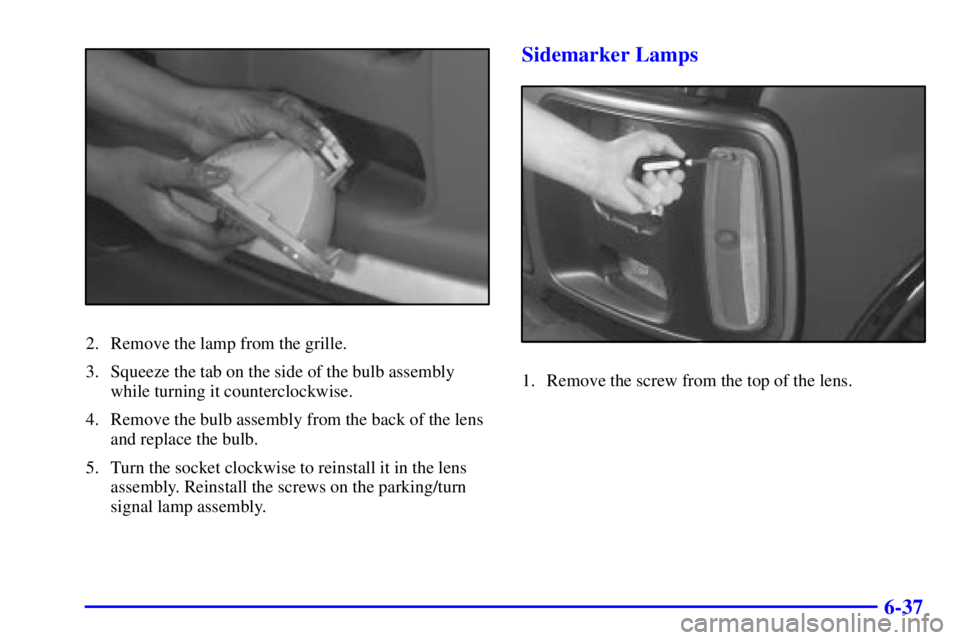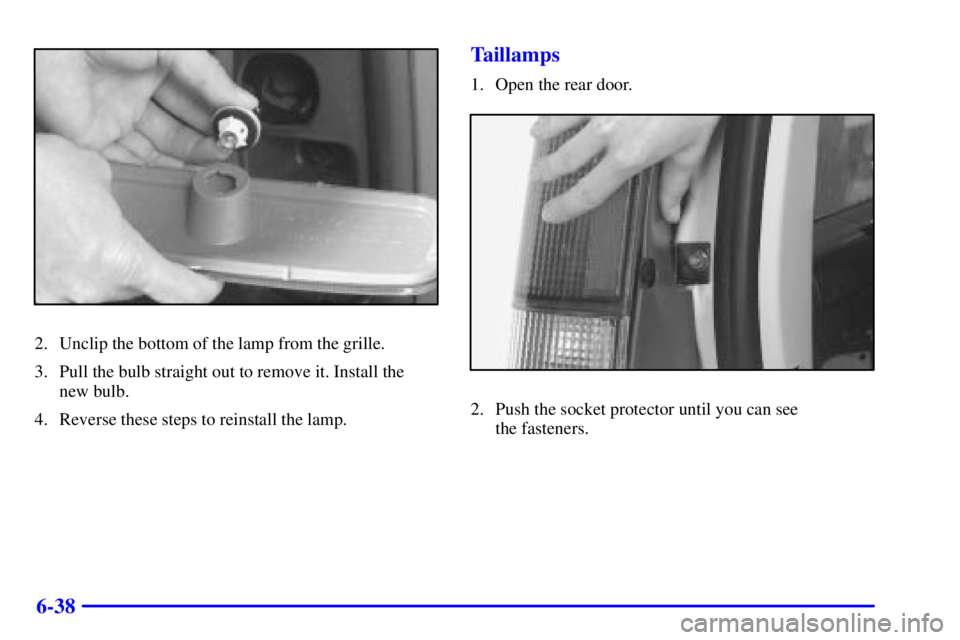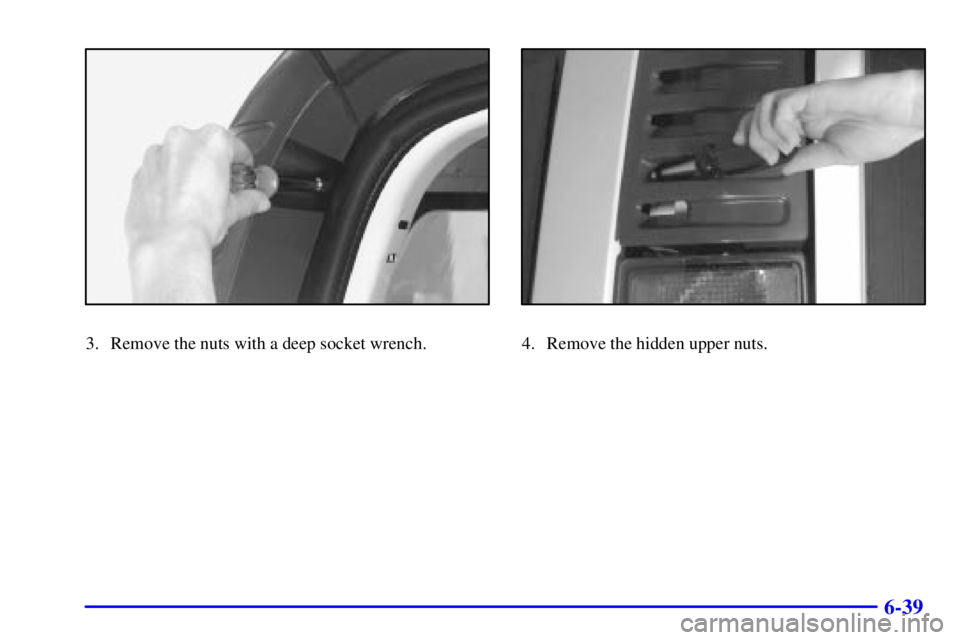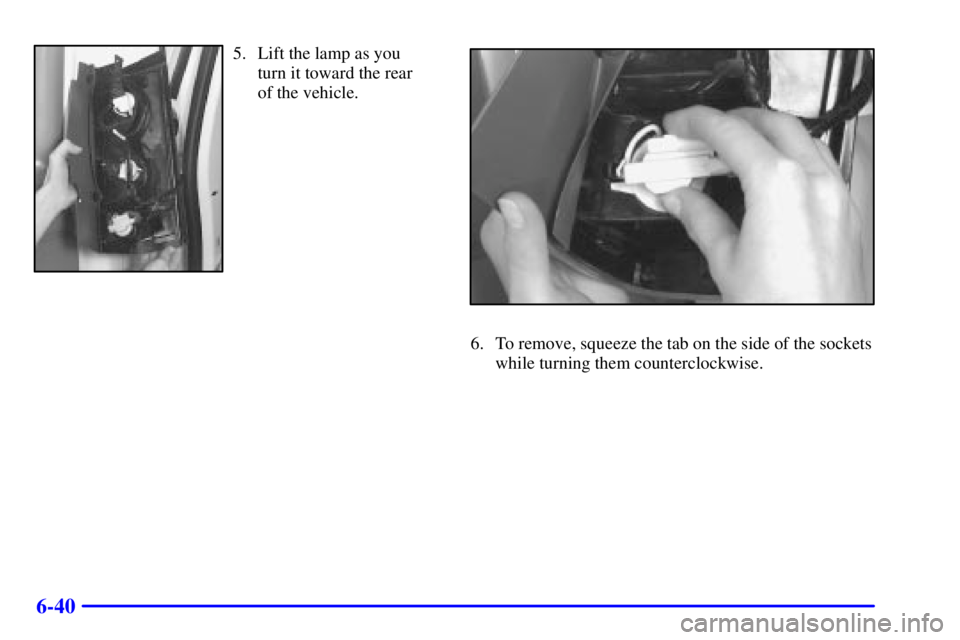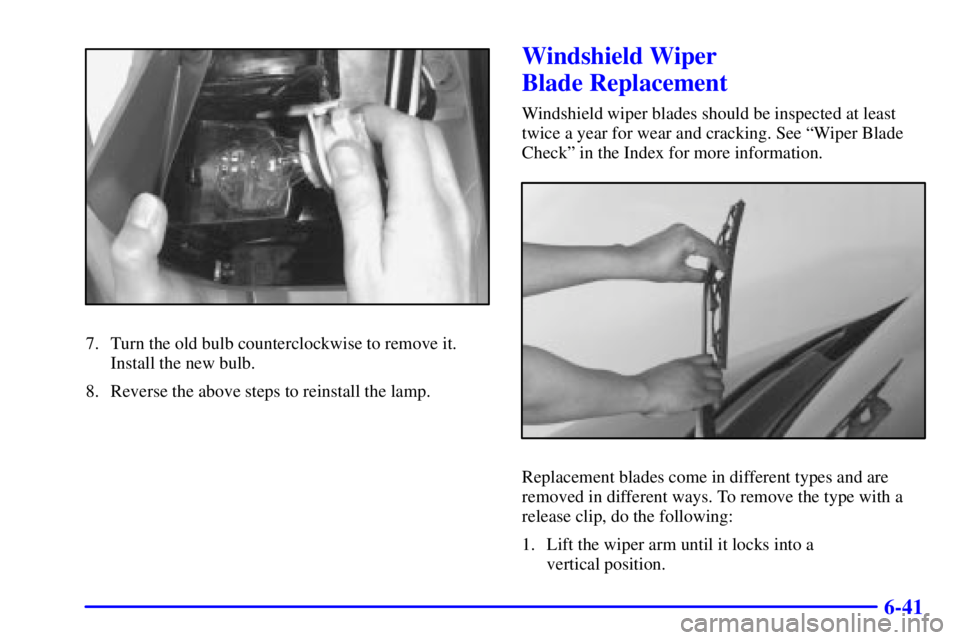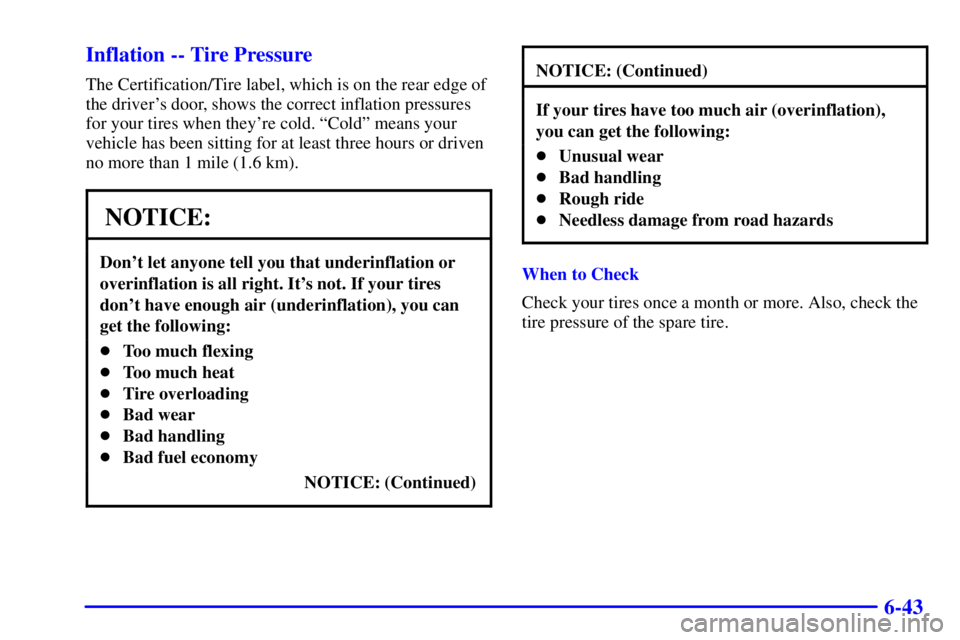CHEVROLET EXPRESS 2002 Owners Manual
EXPRESS 2002
CHEVROLET
CHEVROLET
https://www.carmanualsonline.info/img/24/55834/w960_55834-0.png
CHEVROLET EXPRESS 2002 Owners Manual
Trending: keyless, hood release, open hood, set clock, seats, wheel, roof
Page 301 of 411

6-34 Vehicle Storage
If you're not going to drive your vehicle for 25 days
or more, remove the black, negative (
-) cable from
the battery. This will help keep your battery from
running down.
CAUTION:
Batteries have acid that can burn you and gas
that can explode. You can be badly hurt if you
aren't careful. See ªJump Startingº in the Index
for tips on working around a battery without
getting hurt.
Contact your dealer to learn how to prepare your vehicle
for longer storage periods.
Also, for your audio system, see ªTheft
-Deterrent
Featureº in the Index.
Bulb Replacement
For any bulb changing procedure not listed in this
section, contact your dealer.
For the type of bulbs, see ªReplacement Bulbsº in
the Index.
Halogen Bulbs
CAUTION:
Halogen bulbs have pressurized gas inside and
can burst if you drop or scratch the bulb. You or
others could be injured. Be sure to read and
follow the instructions on the bulb package.
Headlamps
You have either a sealed beam headlamp or a
composite system.
Page 302 of 411
6-35
Sealed Beam Headlamp
1. Remove the four screws from the headlamp retainer.
Pull the retainer out and set it aside.
2. Unplug the lamp assembly from the connector.
3. Remove the old headlamp
4. Install a new headlamp into the assembly.
5. Plug the assembly back into the connector.
6. Reassemble the headlamp assembly with the retainer.Composite Headlamps
1. Open the hood.
2. Locate the rear side of each of the headlamps.
3. Without removing the headlamp assembly itself,
remove the bulb socket from the back of the
headlamp on the driver's side. Turn the bulb
counterclockwise one quarter turn to remove it from
the socket. On the passenger's side, turn the bulb
clockwise one quarter turn. Do not touch the glass
part of the bulb.
Page 303 of 411
6-36
4. Reinstall the new bulb into the socket and return it to
the headlamp assembly.
Front Parking/Turn Signal Lamps
To replace the front parking/turn signal lamps, do
the following:
1. Remove the outer screws from the parking/turn
signal lamp lens assembly. (There are either two or
four screws, depending on your vehicle's trim level.)
Page 304 of 411
6-37
2. Remove the lamp from the grille.
3. Squeeze the tab on the side of the bulb assembly
while turning it counterclockwise.
4. Remove the bulb assembly from the back of the lens
and replace the bulb.
5. Turn the socket clockwise to reinstall it in the lens
assembly. Reinstall the screws on the parking/turn
signal lamp assembly.
Sidemarker Lamps
1. Remove the screw from the top of the lens.
Page 305 of 411
6-38
2. Unclip the bottom of the lamp from the grille.
3. Pull the bulb straight out to remove it. Install the
new bulb.
4. Reverse these steps to reinstall the lamp.
Taillamps
1. Open the rear door.
2. Push the socket protector until you can see
the fasteners.
Page 306 of 411
6-39
3. Remove the nuts with a deep socket wrench.4. Remove the hidden upper nuts.
Page 307 of 411
6-40
5. Lift the lamp as you
turn it toward the rear
of the vehicle.
6. To remove, squeeze the tab on the side of the sockets
while turning them counterclockwise.
Page 308 of 411
6-41
7. Turn the old bulb counterclockwise to remove it.
Install the new bulb.
8. Reverse the above steps to reinstall the lamp.
Windshield Wiper
Blade Replacement
Windshield wiper blades should be inspected at least
twice a year for wear and cracking. See ªWiper Blade
Checkº in the Index for more information.
Replacement blades come in different types and are
removed in different ways. To remove the type with a
release clip, do the following:
1. Lift the wiper arm until it locks into a
vertical position.
Page 309 of 411
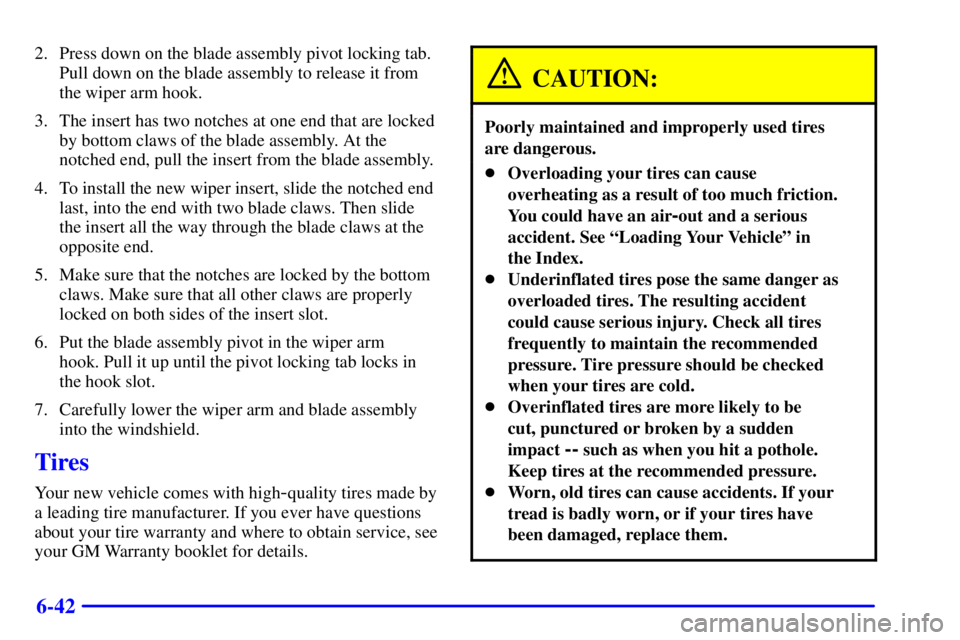
6-42
2. Press down on the blade assembly pivot locking tab.
Pull down on the blade assembly to release it from
the wiper arm hook.
3. The insert has two notches at one end that are locked
by bottom claws of the blade assembly. At the
notched end, pull the insert from the blade assembly.
4. To install the new wiper insert, slide the notched end
last, into the end with two blade claws. Then slide
the insert all the way through the blade claws at the
opposite end.
5. Make sure that the notches are locked by the bottom
claws. Make sure that all other claws are properly
locked on both sides of the insert slot.
6. Put the blade assembly pivot in the wiper arm
hook. Pull it up until the pivot locking tab locks in
the hook slot.
7. Carefully lower the wiper arm and blade assembly
into the windshield.
Tires
Your new vehicle comes with high-quality tires made by
a leading tire manufacturer. If you ever have questions
about your tire warranty and where to obtain service, see
your GM Warranty booklet for details.
CAUTION:
Poorly maintained and improperly used tires
are dangerous.
�Overloading your tires can cause
overheating as a result of too much friction.
You could have an air
-out and a serious
accident. See ªLoading Your Vehicleº in
the Index.
�Underinflated tires pose the same danger as
overloaded tires. The resulting accident
could cause serious injury. Check all tires
frequently to maintain the recommended
pressure. Tire pressure should be checked
when your tires are cold.
�Overinflated tires are more likely to be
cut, punctured or broken by a sudden
impact
-- such as when you hit a pothole.
Keep tires at the recommended pressure.
�Worn, old tires can cause accidents. If your
tread is badly worn, or if your tires have
been damaged, replace them.
Page 310 of 411
6-43 Inflation -- Tire Pressure
The Certification/Tire label, which is on the rear edge of
the driver's door, shows the correct inflation pressures
for your tires when they're cold. ªColdº means your
vehicle has been sitting for at least three hours or driven
no more than 1 mile (1.6 km).
NOTICE:
Don't let anyone tell you that underinflation or
overinflation is all right. It's not. If your tires
don't have enough air (underinflation), you can
get the following:
�Too much flexing
�Too much heat
�Tire overloading
�Bad wear
�Bad handling
�Bad fuel economy
NOTICE: (Continued)
NOTICE: (Continued)
If your tires have too much air (overinflation),
you can get the following:
�Unusual wear
�Bad handling
�Rough ride
�Needless damage from road hazards
When to Check
Check your tires once a month or more. Also, check the
tire pressure of the spare tire.
Trending: warning lights, bulb, seats, child lock, fog light, torque, fold seats



